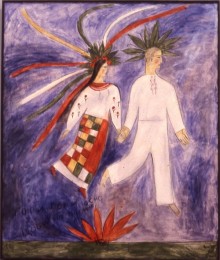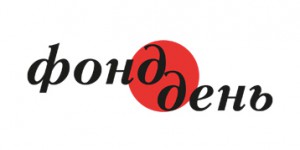Only a part of the artist’s works is displayed at this vernissage. The emphasis of the exposition was made on the series “The Arithmetic of the Landscape” featuring a row of poplars. However, this series fills only a certain niche in Honchar’s work. The painter’s long path to genuine artistic language has led him to minimalism and naive art, to a concise and clear reflection of the state of his soul. Ukrainian theme sounds very convincingly in all his works, since both Honchar and his wife, the famous singer Nina Matviienko, organically grow from the cultural roots of their nation.
“It took me a year and a half to convince Honchar to make this exhibition,” said Alla MARYCHEVSKA, owner of the AVS Art Gallery. “Petro did not agree right away, since he was constantly busy as head of the National Center of Folk Culture ‘Ivan Honchar Museum.’ Besides, he did not paint for a while at all. But when we started talking about the poplar series, Petro finally agreed.
“Why is this exhibition interesting? I have known Honchar since the 1990s, when the creative community ‘The Brotherhood of Alipii,’ to which he belonged, became widely known. Unfortunately, during the past 20 years there has been a lot of ‘foam over the clear water,’ cynicism in art, which artists from ‘The Brotherhood of Alipii’ managed to avoid. During the past few years a lot of artists and viewers felt nostalgia for the depth and honest understanding of history. The main thing in art is sincerity, and that is why I wanted to hold the ‘The Brotherhood of Alipii Year’ in my gallery. We have already shown Nina Denysova’s art to the public, now we are exhibiting Petro Honchar’s works, and then we are planning to organize an exhibition by Oleksandr Melnyk.
“I think Honchar’s ‘poplars’ are a symbol of Ukrainism, they are as ascetic as a prayer or mantra. This is a simultaneous aspiration to reach the sublime spheres and some sort of ‘grounding.’ Poplars as an ontological vertical are an expression of material, subjective, biological (living), and social existence. At the same time, it is a symbol in mythology and folklore: in the 1990s Serhii Plachynda published a small glossary of Old Ukrainian mythology, which contained the following legend: the Sun god Svaroh fell in love with a girl called Polia, but she did not love him back and ran away from him all the time (this is a symbol of the Sun moving in a circle, and the girl instead is running away from it). Hurt by his unshared love, Svaroh said: ‘If you are not mine, you will not be anyone else’s,’ and turned the girl into a slender poplar. And the other girls, who saw this metamorphosis, looked at the tree and said: ‘This is Polia’ [In Ukrainian ‘To Polia,’ which is homonymous to topolia, “poplar.” – Ed.], because they recognized the girl’s soul in the tree.”
A number of other paintings are exhibited, among them Dedication to Boichuk (a tribute to boichukists, who influenced the shaping of Honchar’s style), a brilliant painting On a Wild Cherry Tree and St. Peter and Paul’s Church from the series “Destroyed Temples of Kyiv.”
Among the paintings of the early period, there is a portrait of the artist’s wife, created in 1991. And the diptych Here We Go! depicting a person who is trying to reach a star, was created in 1994. And the canvas Memory of Mamai was painted in 1995.
There are three clean canvases in the exhibition that adorn one of the walls. The artist says those are his three most perfect works.
“When I enlisted in the army after graduating from the institute, I burned everything,” Honchar says. “I thought about giving up painting for good. I was in that kind of mood. I studied during the times when social realism and academicism reigned, and this depressed me a lot, I did not want to paint. I thought I would be free, but not an artist! But I could not run away from painting. I am almost quoting naive drawing, I am trying to get rid of the direct realistic portrayal, since realism provides only an external ‘shell.’ And I did not want anything but the very essence, the idea to break free from the form. The more you destroy the form, the more you can use it to model your internal world or philosophy.”
There are several landscapes from the artist’s recent works. They have been created in a slightly different manner a few years ago. “It is expressionism. I do not know why I wanted to paint in that way,” Honchar says.
A series which contains poplars and non-poplars is a whole separate world. The artist was inspired by the outskirts of his village. “You go that way – you see poplars, you go the other way – you see poplars again,” says Honchar. “And they got stuck in my mind, somehow. And this combination of vertical, they are so long, and horizontal. This is infinity in both directions.”
The exhibition is open through April 12.







